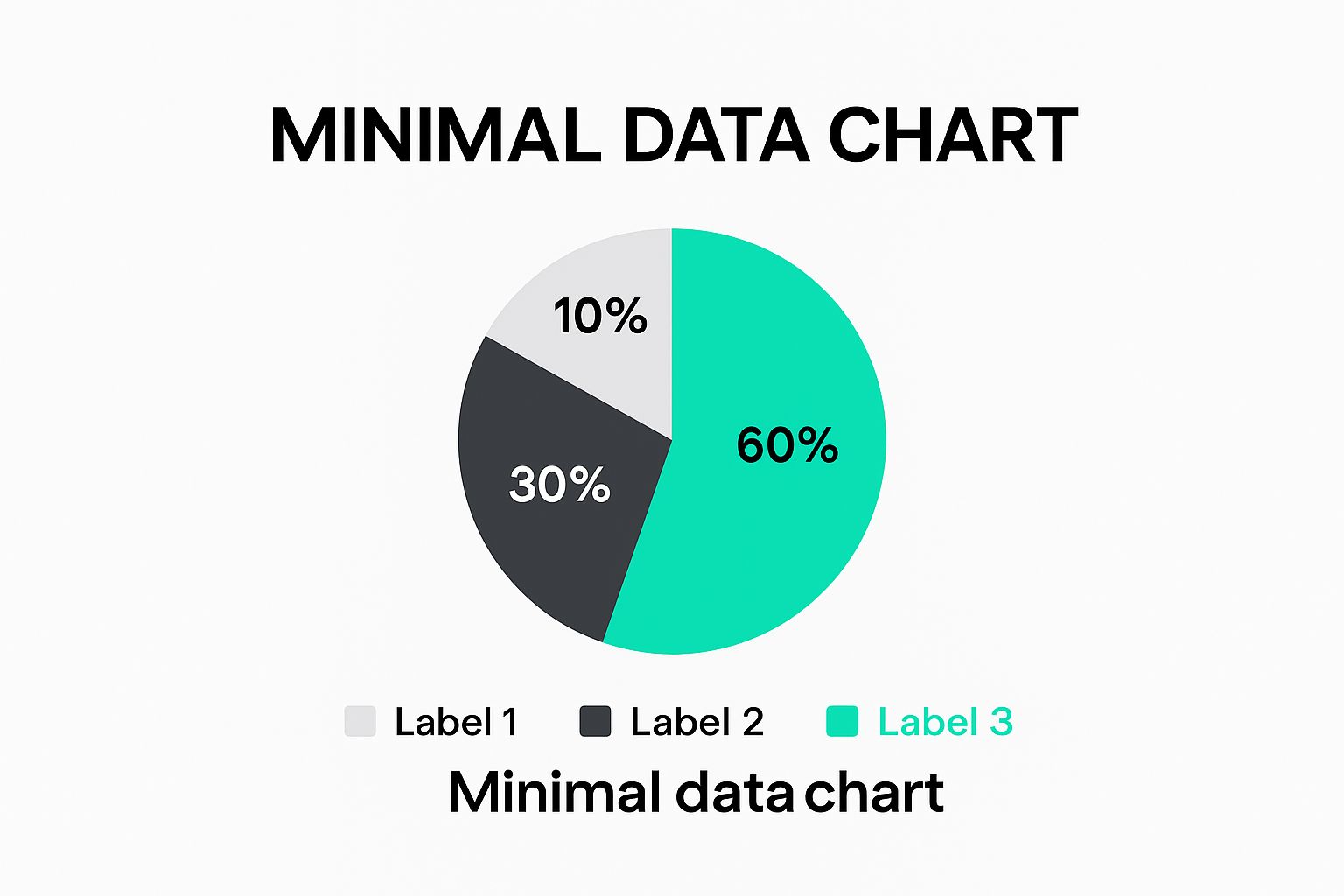What Actually Makes Service Company Websites Convert

Let's be honest about website design for service companies. I've seen how a small change can completely transform lead generation. Forget the bells and whistles; it’s about knowing your audience and creating an online experience that resonates with them. For example, I recently helped a plumbing company struggling against bigger competitors. Their website was a mess – contact info buried deep within the site.
We stripped it down. We created a clean homepage with clear calls to action, easy-to-find contact details, and real testimonials. The result? A 20% increase in leads within the first month. We didn't reinvent anything; we just made it easier for customers to find what they needed and get in touch. Your website design is crucial for attracting clients, especially when you're focusing on a solid SEO website structure. This involves creating a website that is both visually appealing and effective in guiding visitors towards your services.
First Impression Factors That Matter Most
You only get one shot at a first impression, especially with websites. Visitors decide in seconds if your site is worth their time. Let’s look at the most crucial elements:
I want to give you a clear picture of what makes a strong first impression, so I've put together a table summarizing the key elements. This table will help you prioritize what to focus on as you build or revamp your site.
Let's talk about what visitors see in those first few seconds. What builds trust and makes them want to stick around? Here's a table breaking it down:
Table: First Impression Factors That Matter Most
Description: Key website elements that influence visitor trust and credibility within the first 15 seconds.
| Design Element | Impact on Trust | Implementation Priority |
|---|---|---|
| Clear Value Proposition | High | Essential |
| Professional Design | High | Essential |
| Easy Navigation | High | Essential |
| Testimonials/Social Proof | Medium | High |
| Contact Information Accessibility | High | Essential |
| Mobile Responsiveness | High | Essential |
Think of it like a physical store. Is it clean, organized, and inviting? Does it project professionalism and trustworthiness? Your website should do the same. Design isn’t just about looks; it’s about functionality and user experience. Speaking of trust and professionalism, studies show that 94% of first impressions are design-related, and 75% of users judge credibility based on the website. This emphasizes the need to invest in professional web design. Discover more insights about web design stats. A well-designed site communicates your brand and builds trust. Make sure it's easy to navigate, mobile-friendly, and looks professional.
Thinking About Your Website Like a Strategic Investment

The infographic above highlights the critical role of responsive design. See how a consistent brand experience flows seamlessly from desktop to mobile? That's crucial for building trust and making sure every visitor has a smooth experience, no matter how they access your site. If you're looking for a web design partner, our guide on How to Choose a Web Design Company can help.
Too many service companies see their website as just another cost. But savvy business owners know their website is their hardest-working salesperson – one that's on the clock 24/7. This means approaching your website strategically. It needs to be tightly aligned with your business goals.
Are you focused on generating leads for your HVAC business? Maybe you're trying to book consultations for your financial planning services? Defining your key performance indicators (KPIs) upfront is essential, even before you start brainstorming design ideas.
Think about it: would you hire a salesperson without setting sales targets? Your website deserves the same careful planning. Understanding your customer journey is just as important. How do people find your service? What are they looking for when they land on your site? Mapping this out will inform your website’s structure and content. A plumbing company specializing in emergency calls, for instance, might prioritize a prominent phone number and clearly defined service areas right on the homepage. For example, if you’re looking to improve your conversion rates, check out these strategies for improving your websites conversion rates.
This strategic approach saves you money down the line. By understanding your audience and their behavior, you can avoid costly redesigns and wasted marketing spend. Imagine a marketing consultancy that wants to book more discovery calls. Their website needs a clear call to action, compelling case studies, and maybe even a scheduling tool integrated directly into the page. A well-designed website works tirelessly for your service business, attracting and converting leads while you sleep. It's an investment that pays back big time.
Planning Your Website: A Checklist Approach
Before diving into design, a solid plan is essential. The table below provides a quick checklist of key planning considerations for different service businesses. It highlights the relationship between your primary business goal, the features your website needs, and your likely investment.
Website Planning Checklist by Service Type
| Service Type | Primary Goal | Key Features Needed | Typical Investment |
|---|---|---|---|
| HVAC Repair | Generate Leads | Contact Forms, Service Area Map, Emergency Contact Number | $3,000 – $7,000 |
| Financial Planning | Schedule Consultations | Online Booking System, Client Testimonials, Blog with Financial Advice | $5,000 – $10,000 |
| Marketing Consultancy | Book Discovery Calls | Compelling Case Studies, Clear Call to Action, Integrated Scheduling Tool | $7,000 – $15,000 |
| Plumbing Services | Emergency Service Requests | Prominent Phone Number, Service Area List, Online Booking for Non-Emergencies | $4,000 – $8,000 |
As you can see, your website’s features should directly support your primary business goal. And while the investment can vary, consider it a down payment on future growth. A strategically designed website is not an expense; it’s an investment in your business’s success.
Creating Experiences That Guide Visitors to Your Phone

I've seen a lot of service company websites, and the biggest mistake? Designing for the owner, not the customer. Take a cleaning company, for example. They might want to show off every single cleaning service they offer, a huge catalog of options. But the customer just wants to book a cleaning – simple as that. A streamlined, three-click contact process is often way more effective than complex navigation. I actually worked with a cleaning company that saw a 30% increase in leads just by simplifying their contact form.
Designing for Your Ideal Client
Website design for service businesses really boils down to user experience (UX). It's about understanding your target audience. A financial advisor, for instance, might use a homepage quiz asking about financial goals. This educates visitors and subtly qualifies leads before they even contact the advisor. It’s like a virtual gatekeeper, making sure only serious prospects get through.
Navigation That Makes Sense
Intuitive navigation is key. Imagine you're on your phone, frantically searching for a plumber because a pipe just burst. You're not going to wade through "About Us" or "Our History." You need that plumber's number – now. This highlights the importance of mobile responsiveness. With roughly 90% of websites already using responsive design, it’s clearly essential, particularly for service businesses. You have to make your website easy to use on any device.
Presenting Complex Services Simply
Even the most complex services can be explained simply. Use clear visuals, short, punchy explanations, and maybe even a quick explainer video. It’s about showing, not just telling. Make the information easy to digest, even on the go.
Turning Browsers into Callers
The ultimate goal? Turning those hesitant browsers into paying customers. Clear calls to action, easy-to-find contact info, and testimonials all build trust and encourage contact. It’s not about pushy sales tactics; it’s about giving visitors the information they need to feel comfortable reaching out. Think of your website as your digital storefront – every detail matters. You want that friendly, welcoming feeling, even online.
Using Smart Technology to Outshine Your Competition
A website is like your business's online storefront. A fresh coat of paint helps, sure, but what really sets you apart these days is smart technology. Think of it as giving your online presence a serious upgrade. I've seen firsthand how the right tech can make client interactions feel personal and efficient at the same time.
Take a local law firm, for example. Imagine them using an AI-powered chatbot like Chatiant to pre-qualify leads even after the office closes. They're capturing valuable information 24/7. Or picture a home renovation company using a smart scheduling system. No more endless email chains – their team can focus on the actual renovations. This isn't some far-off future; it's happening right now.
Choosing the Right Tech for Your Service Business
Now, the key isn’t to just grab every shiny new gadget. It’s about picking the technology that actually solves your specific problems and wows potential clients. Where are your biggest bottlenecks? Are you drowning in admin tasks? Missing out on leads after hours? Frustrating clients with a clunky booking system? Figure out your pain points, then start exploring solutions.
Let me give you a concrete example. I once worked with a small consulting firm that was losing leads because their website was slow and difficult to navigate. They were spending too much time on manual follow-ups, too. By implementing a streamlined contact form and integrating a CRM, we saw a 20% increase in leads in just three months. They were able to respond faster and more effectively, which made a huge difference. It also freed up their time to focus on what they do best: consulting.
Practical Applications of Smart Technology
Let’s talk specific examples of tech that can transform your website:
- AI-Powered Chatbots: Think 24/7 customer support, instant answers to FAQs, and even lead qualification while you sleep.
- Smart Scheduling Systems: Empower clients to book appointments online, eliminating back-and-forth emails and saving you precious time.
- Personalized Content: Imagine your website adapting to each visitor, showing them the most relevant information based on their behavior.
- Automated Email Marketing: Nurture leads with targeted email campaigns triggered by specific actions on your website.
Think of web design statistics. Over 50% of web designers use AI for things like creating images. And a whopping 70% of Gen Z users actually expect websites to anticipate their needs (SLT Creative). This is where AI and machine learning come into play.
By strategically implementing these technologies, you're not just building a website; you're creating a client magnet. You're positioning yourself as a modern, efficient, and client-focused business. And that’s how you truly stand out from the competition.
Building Instant Trust Through Smart Design Choices
Trust is the name of the game when someone's thinking about hiring a service company. Your website has a mere blink of an eye to make a good first impression. Let's talk about how successful service businesses nail that first impression using smart design, genuine testimonials, and compelling case studies. I've seen firsthand how the right approach can completely change a service company's online game.
Show, Don't Just Tell: Real-World Examples
I worked with a pest control company once that saw a huge spike in calls simply by ditching generic stock photos and replacing them with real before-and-after pictures of their work. This small change spoke volumes to potential customers because it showed real results. Way more effective than a cheesy stock photo ever could be.
Similarly, a business consultant I know found that client stories, presented as mini-case studies, were converting way better than traditional testimonials. These stories gave specific examples of how the consultant helped clients overcome challenges and reach their goals.
This principle works across all kinds of service industries. Think about it: a landscaping company showing off gorgeous photos of their finished projects, a cleaning service displaying sparkling clean homes, or a repair technician providing detailed explanations of their process – these visuals build trust by demonstrating actual expertise. Want more web design tips? Check out our guide on web design best practices.
Creating a Professional Vibe with Visuals
Certain visual elements instantly scream professionalism and reliability. A clean, modern design, high-quality images, and easy-to-read fonts all contribute to that crucial positive first impression. Think of your website as your digital storefront. It needs to be welcoming and well-maintained.
Content Strategies That Click
Different service industries need different content strategies. A lawyer might highlight successful cases, while a plumber might focus on clear service descriptions and emergency contact info. The core idea, though, is always the same: give potential clients the info they need to make a smart decision. Your website isn't just about looking good; it's about solving your customer's problems.
Showcasing Expertise Without Overdoing It
Finding the sweet spot between showing off your expertise and providing essential info is key. It's tempting to list every single detail about your services, but often visitors just want to know if you can solve their specific problem. Keep your content concise, focus on benefits, and make it easy for visitors to find what they need. A confused visitor rarely becomes a client.
Prioritize clear calls to action and easy-to-find contact info. This makes it easy for visitors to reach out and take the next step.
Getting Found When People Need Your Services Most
Having a beautiful website that doesn't show up in search results is a bit like having a killer sports car stuck in the garage. What's the point, right? For service businesses, visibility is king. So, let's talk about some down-to-earth SEO strategies, particularly local SEO, to get your service company noticed online. Google's own SEO starter guide is a great place to start, and I highly recommend it: This screenshot really highlights the importance of unique and accurate page titles, which are crucial for both user experience and search engine understanding. It reinforces that good SEO is all about getting helpful info to people easily.
Structuring Your Content For People and Search Engines
Your website content needs to resonate with both humans and search engines. It's a balancing act. Think of it as crafting compelling sales copy for your ideal clients while subtly dropping hints to search engines about what you offer and where. Let's say you're a plumber in Johnson City. Your website copy should naturally weave in phrases like "plumbing services in Johnson City" or "emergency plumber Johnson City." This tells Google exactly what you do and your service area. Speaking of local SEO, you might find this helpful: our ultimate local SEO checklist.
I’ve found that creating content around common questions your customers ask is really effective. Think about the things people always want to know before hiring a plumber – what are your rates, what areas do you service, do you offer emergency services? Answering these questions clearly and concisely on your website not only helps potential customers but also boosts your SEO.
The Technical Side of SEO: What You Need to Know
Technical SEO might sound scary, but it’s really about making your website easy for search engines to navigate and understand. It's like organizing your toolbox. A well-organized toolbox with clear labels means you can find the right tool quickly and easily. For websites, this means things like good page speed, mobile-friendliness, and a clear sitemap. This not only improves your search ranking but also creates a smoother experience for visitors.
I once had a client whose website loaded incredibly slowly. We discovered that some large image files were the culprit. After optimizing those images, we saw a significant improvement in both page speed and search ranking. It's a small tweak that can make a big difference.
Leveraging Reviews and Local Citations
Think of online reviews and local citations as digital word-of-mouth. Positive reviews build trust and give you a serious local SEO boost. Similarly, getting listed on relevant online directories helps potential clients find you when they search for services in their area. Think Yelp, Google My Business, etc. – you want to be where your customers are looking.
Early in my career, I worked with a small bakery that was struggling to get online visibility. We encouraged them to actively request reviews from their happy customers and get their business listed on relevant local directories. Over a few months, their online presence blossomed, and they saw a notable increase in new customers.
Building a Sustainable SEO Strategy
SEO isn't about overnight miracles; it's a marathon, not a sprint. By consistently creating valuable content, optimizing your website's technical structure, and earning positive reviews, you'll build a solid online presence that naturally attracts clients and delivers steady growth. This approach isn't just about ranking higher; it’s about building trust and establishing yourself as a reliable service provider in your area.
One of the biggest mistakes I see businesses make is thinking of SEO as a one-time fix. It's an ongoing process. Just like a garden needs regular tending to thrive, your website needs regular SEO care to flourish in the search results.
Launching Smart and Tracking What Really Matters
Launching your website is a huge milestone, but it's really just the beginning. The real work starts after you go live, when you can finally see how real people interact with your site. This isn't about guessing; it's about using data to make informed decisions. You need to track the metrics that actually matter for a service business, like lead quality and those crucial conversion rates that turn into paying clients.
Understanding Your Website's Performance
Don't drown in data. Focus on the tools that give you clear, actionable insights. I've seen so many business owners get overwhelmed by complex analytics dashboards, and they end up just giving up. Start simple. What are your top three goals for your website? Lead generation? Booking appointments? Direct sales? Choose tools like Google Analytics that align with those specific goals.
For example, if your primary goal is lead generation, keep a close eye on contact form submissions and phone calls that originate from your website. If you're running an e-commerce site, track your conversion rates, average order value, and cart abandonment rates. The key is to find the tools that give you the most relevant information without needing a degree in data science.
User Behavior: Your Secret Weapon
Understanding how visitors navigate your site is invaluable. It shows you where they get stuck, what content resonates with them, and what might be driving them away. This isn't about spying on users; it's about finding ways to improve their experience.
For instance, a high bounce rate on a specific service page might indicate unclear content or slow loading times. If people consistently abandon their carts at checkout, the process might be too complicated, or maybe there are unexpected fees. These patterns can reveal valuable areas for improvement.
Optimizing for Impact
Once you have the data, it's time to put it to work. Prioritize changes that will have the biggest impact on your bottom line. Sometimes a small tweak, like repositioning a call-to-action button, can make a world of difference. Other times, you might need to revamp entire sections of your site.
I once worked with a local restaurant that had a beautiful website, but their online ordering system was buried deep in the navigation. Simply moving the "Order Now" button to the top of the homepage resulted in a 40% increase in online orders in just the first month! Small change, big impact.
Successful service companies treat website analytics like a compass, constantly adjusting their direction based on real-world data. By making website optimization a regular practice, you ensure your site continues to attract clients and generate revenue.
Ready to create a website that works as hard as you do? Swish Web Designs can help. We handle everything from design and development to SEO and ongoing maintenance. Let us help you build your dream website.


